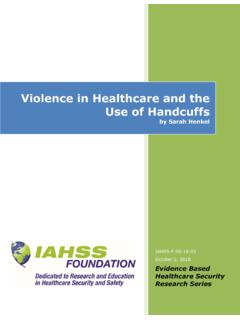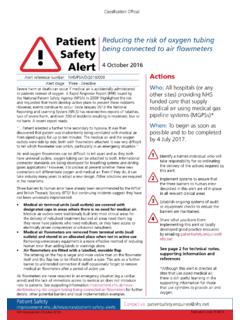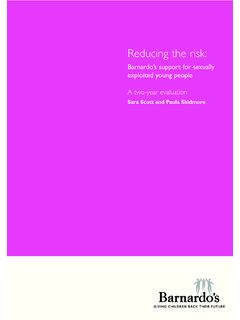Transcription of Reducing Violence Toward Healthcare Workers: The Value …
1 Reducing Violence Toward Healthcare Workers: The Value of At-Risk Patient Screening IAHSS-F RS-17-02. Nov. 14, 2017. Evidence Based Healthcare Security Research Series IAHSS Foundation The International Association for Healthcare Security and Safety - Foundation (IAHSS. Foundation) was established to foster and promote the welfare of the public through educational and research and development of Healthcare security and safety body of knowledge. The IAHSS Foundation promotes and develops educational research into the maintenance and improvement of Healthcare security and safety management as well as develops and conducts educational programs for the public.
2 For more information, please visit: The IAHSS Foundation creates Value and positive impact on our profession and our industry ..and we are completely dependent on the charitable donations of individuals, corporations and organizations. Please realize the Value of the Foundation's research and help us continue our mission and our support to the Healthcare industry and the security and safety professionals that serve our institutions, staff and most importantly our patients. To make a donation or to request assistance from the IAHSS Foundation, please contact Nancy Felesena at (888) 353-0990.
3 Thank You for our continued support. Karim H. Vellani, CPP, CSC. Committee Chair IAHSS Foundation IAHSS Foundation's Evidence Based Healthcare Security Research Committee RON HAWKINS KARIM H. VELLANI, CPP, CSC. Security Industry Association Threat Analysis Group, LLC. MAUREEN MCMAHON RN, BSN, MS BRYAN WARREN, MBA, CHPA, CPO-I. Boston Medical Center Carolinas Healthcare System BONNIE MICHELMAN, CPP, CHPA THOMAS TAGGART. Massachusetts General Hospital/Partners Paladin Security Healthcare Page |1. Introduction The Healthcare industry by its nature suffers from Violence due to many factors such as behavioral health clients visiting during a mental crisis, patients' negative reactions to painful treatment or unfavorable diagnoses, criminal activity, etc.
4 An unfortunate fact is that the primary subjects committing Violence are the very patients being cared for. In late 2015, Occupational Safety and Health Administration (OSHA) publication 3826 noted patients as being the largest source of Violence in Healthcare settings at 80 percent, with 12 percent being attributed to other clients or The factors contributing to the risk of Violence in the Healthcare arena include: patients with undiagnosed mental health issues, visitors comprised of a wide spectrum of persons from the surrounding area, including those needing treatment, those visiting their loved ones during a personal crisis, and others who are highly unstable, forensic prisoner patients, and those present for the express purpose of committing a crime.
5 Healthcare facilities offer 24-hour open access to the public, many with numerous points of ingress and egress, people visiting the facility are often times in the midst of a crisis posing great unpredictability. These factors, along with staff shortages, lengthy waits and a high stress environment, present a recipe for disruptive behaviors. Healthcare professionals need to learn to identify common warning signs exhibited by would-be violent patients. In doing so, they may be equipped with the necessary skills to avoid the associated costs of routine workplace Violence , and be able to mitigate negative outcomes.
6 This material will provide Healthcare workers with the knowledge base, situational awareness tools, and other necessary skills to recognize threats early, respond appropriately and avoid becoming victims themselves. The Scope and Impact of Disruptive Behaviors in Healthcare Environments When patients exhibit violent behaviors in Healthcare facilities, the impact can have reverberating consequences. The quality of care provided may be affected when the safety of patients and staff is disrupted. The Joint Commission (TJC), the largest accrediting agency for hospitals in the United States, has stated that risk management programs should, of necessity, address disruptive behaviors as a human factor affecting the delivery of care to patients.
7 TJC Sentinel Event Alert #57 highlighted the following: Page |2. The Joint Commission introduced safety culture concepts in 2008 with the publication of SEA #40 on behaviors that undermine a culture of safety. Further emphasis was made the following year with an alert (previously SEA #45, now supported with SEA #57) on leadership committed to safety, and the establishment of a leadership standard requiring leaders to create and maintain a culture of safety. The Patient Safety Systems chapter of The Joint Commission's Comprehensive Accreditation Manual for Hospitals emphasizes the importance of safety culture.
8 As of Jan. 1, 2017, the chapter expanded to critical access hospitals, as well as ambulatory care and office-based surgery The costs of ignoring the issue of patient Violence are massive. The Emergency Care Research Institute (ECRI) included the need for managing patient Violence in acute care settings among its 2015 List of 10 Patient Safety Concerns: 1. Alarm hazards: inadequate alarm configuration policies and practices 2. Data integrity: incorrect or missing data in EHRs and other health IT systems 3. Managing patient Violence 4. Mix-up of IV lines leading to misadministration of drugs and solutions 5.
9 Care coordination events related to medication reconciliation 6. Failure to conduct independent double checks independently 7. Opioid-related events 8. Inadequate reprocessing of endoscopes and surgical instruments 9. Inadequate patient handoffs related to patient transport Page |3. 10. Medication errors related to pounds and kilograms3. In 2016 and 2017, ECRI continued to emphasize this by identifying behavioral health issues in non-behavioral health settings as an arena wherein Healthcare staff often become frustrated when faced with Violence from patients, stating, We're very reactive, and that's part of the problem.
10 It was suggested that a thorough assessment of risks of Violence from patients, as well as appropriate training on identifying early warning signs and consistent training and drills, could mitigate the consequences of ,5. Department of Labor and OSHA 3148 reported that, in the Healthcare and social assistance sector, 13 percent of injuries and illness were the result of Violence and the incidents of Violence in Healthcare was cases per 10,000 workers, which is roughly four times the rate of all other cases in the private sector in the United States.








